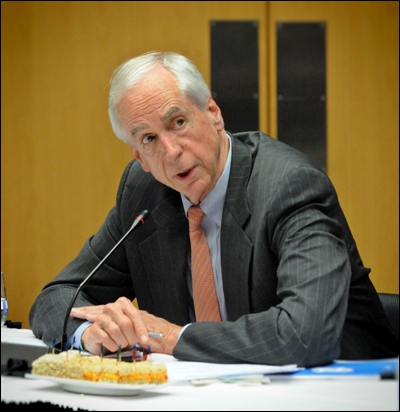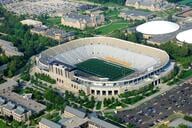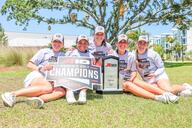You have /5 articles left.
Sign up for a free account or log in.

Hunter Rawlings speaks to UNC students and staff about his panel's work on the campus.
University of North Carolina at Chapel Hill
As president of the Association of American Universities, Hunter Rawlings is well aware of the fate met by numerous reports urging reform in college athletics: recommendations, however sound and well thought-out, go nowhere in the face of pressure to keep recruits coming and cash flowing to big-time sports programs.
But this time is different, he insisted Tuesday while announcing the suggestions of a panel he chaired at the request of former University of North Carolina Chancellor Holden Thorp, who sought advice on how UNC and its peers might “tackle what most agree is a challenging issue for all of higher education.”
“The national scene now is one of great change and calls for further change,” Rawlings said in a call with reporters, pointing to an ongoing lawsuit accusing the National Collegiate Athletic Association of ignoring the dangers of concussions, and recent calls by major conference commissioners -- one of whom worked with Rawlings on the report -- for structural change within the NCAA. “We think that in that context, it’s more likely that change will occur.”
Though its recommendations (which will sound largely familiar to those who follow college sports reform efforts) are vast in scope, addressing the proper role of everyone from trustees to tutors, when you get right down to it the Rawlings panel’s report is about keeping athletics in its proper place: second to academics.
While the panel was asked to suggest how UNC specifically could best manage athletics going forward, its findings are “worthy of wider discussion at a national level,” Big Ten Commissioner Jim Delany noted.
“A great athletic program by definition must not only align itself with the values of a great university, but it must also meet its regulatory obligations, and it must also avoid undue influence,” said Delany, who runs the richest conference in college sports, but one whose members are also part of the prestigious Committee on Institutional Cooperation research consortium. “There must be bright lines to delineate the assignment of responsibility and authority so that as a result, institutional control can be established and maintained.”
The issues and scandals that led Thorp to request the report are by no means limited to UNC, the panel makes clear, but the recommendations are meant to first inspire model programs and new approaches at that institution before catalyzing other universities to do the same. With its combination of high-octane athletics and high-caliber academics, North Carolina has had a long tradition of wrestling with the tensions inherent in big-time college sports, dating to the reform-minded presidency of William C. Friday in the 1960s and to a fledgling, and ultimately failed, faculty effort to jumpstart a unilateral pullback in athletics in the late 1980s.
Shortly before leaving to become provost at Washington University in St. Louis – Thorp resigned following a massive academic scandal involving years of no-show classes, widely believed to be for the benefit of athletes -- the former chancellor explained his reasons for soliciting advice at a packed town hall meeting on the UNC campus in April, where the panel updated students, faculty and staff on its progress.
"Presidential control was supposed to produce less corruption, make it easier to make rules, reduce escalation of money in college sports, give academics the ability to change college sports," Thorp said, shortly after his controversial claim that presidents either need to "acknowledge that athletics is the most important part of their job" or put athletic directors back in charge and hold them accountable for lapses. "It's almost hard to keep from laughing when you say those things, because obviously, it hasn't worked."
Oversight and Management
The panel argues that while college presidents should maintain “ultimate authority, responsibility and accountability” for the administration of their college sports programs, when it comes to the athletics department, that authority should be delegated to the athletics director.
Operational independence is a major theme running throughout the report, which states that:
Written procedures should ensure that the people charged with the conduct of the athletics program (academic support services, student conduct officers, medical and athletic training staff, admissions directors, etc.) can do their jobs without being subject to “improper influence” by anyone on campus or off -- boosters, politicians, long-tenured coaches or anyone else.
The idea that athletes should be subject to the same disciplinary standards as other students is unlikely to draw protest – publicly, at least. But keeping the admissions process “essentially the same” for all students will face more resistance – in fact, that’s one recommendation that’s been around for years and never gone anywhere.
Because the NCAA standards that athletes need to meet to compete as freshmen (a 2.0 grade point average, rising to 2.3 in 2016, and scores of at least 900 on the SAT or 75 on the ACT), athletes are often enrolled under special admit policies – and, subsequently, struggle to succeed in the classroom. In addition to equalizing admissions, the panel recommends that freshmen with “academic deficits” be barred from competition their first year, to give them time to catch up (it also suggests limiting time spent on sports for all athletes).
“This, of course, has long been called for but not adopted. That’s a typical problem in that no one wants to do this on his or her own for fear of competitive disadvantage,” Rawlings said. “We’re hoping that something might be done in this area to – again – put the emphasis on academics in a domain where academics are often taking a back seat to athletics.”
An annual internal audit and external audit every four years should be conducted to ensure compliance with these measures, the report says, and staff should have a way to report “if delegations are compromised” at the expense of institutional control.
A New Financial Appoach
As the panel member Amy Perko, who chairs the Knight Commission on Intercollegiate Athletics, has said many times, the gap between athletic and academic spending is -- for lack of a better word -- huge. With more money coming in through lucrative television contracts, the biggest programs escalate spending on everything from coaching contracts to scholarships to lavish facilities, while the smaller ones try (and generally fail) to keep up. Yet, none of them, with the exception of about two dozen, actually turn a profit.
“The academic enterprise isn’t growing and the athletic is,” Delany said. “There’s no doubt about it that it’s expensive to support broad-based programs, but it’s also true that the constraints are not built into the system, and we have a very difficult time managing it.”
While implementing spending caps on “specific sports” (read: football and men’s basketball) either at the conference or NCAA level, will likely be a tough sell, the report urges UNC to consider it, noting that legal experts say a total limit on operating expenses could help preserve athletic programs.
“These trends just are not sustainable, and in some cases not appropriate, for the goal of ensuring that athletics is strengthening the academic mission of the university,” Perko said, noting that athletic spending has been escalating at a rate twice as fast as academic spending across Division I. “The broad mission of college sports is to provide opportunity, and not just for one or two sports.”
Still, other recommendations seem more feasible. UNC should make financial data more transparent by clearly delineating how much is spent on what -- e.g., educational development like scholarships vs. operating costs like team travel – and publishing that and other reports showing long-term debt and rates of change.
Whether the NCAA or Atlantic Coast Conference requires it or not, UNC should “commit to maintaining responsible spending patterns,” the report says, and should consider leading the ACC, NCAA and peer institutions “to promote broader changes to the financial model” of Division I.
That might involve incentives to discourage excessive spending, or a cap on university subsidies for athletics, the report says. As for the money any university's programs receive for making the football and basketball postseason – that could be redistributed to promote education and development.
The report also suggests considering providing additional financial aid to help cover the cost of attendance; scholarships often fall short.
Teaming Up With Peers
While UNC has an opportunity to lead the way on this, the panel said, the university can’t do it alone. A better approach would be to form a consortium of universities with similarly high academic standards to share data and ideas, influence legislation, and form a critical mass so that individual institutions will be less hesitant to make changes that might be perceived as athletically disadvantageous.
It shouldn’t just be athletics directors running the show, either. Along with A.D.s, faculty athletics representatives, senior women’s administrators, and heads of academic services, compliance and finances should also help drive best practices – as well as athletes themselves.
Admissions, Eligibility and Time Requirements
In addition to taking a hard look at special admits – “the NCAA initial eligibility standard should not be regarded as an automatic proxy for admission, since there is no evidence that this threshold serves as an accurate predictor of academic success at UNC,” the report says – officials should do “qualitative assessments” of at-risk recruits, considering whether their academic and attitudinal qualities are on par with the student body’s.
Pitching their “year of readiness” idea, the panelists emphasize that freshmen who would not compete but have limited participation at practice would be working through “a robust academic remediation program” – not courses with short-term eligibility in mind.
The NCAA actually created a similar rule recently. Starting in August 2016, freshmen who don’t meet a newly raised initial eligibility standard can qualify for an “academic redshirt year,” where they’d still receive a scholarship and build up course credit while sitting out competition.
Despite an NCAA rule limiting to 20 hours per week the amount of time athletes can spend on required sports activities, many students report spending more time on their sport than on their studies, the report says. It suggests UNC consider “reducing the number of hours” athletes must devote to sports activities.
Education for Coaches
To improve the relationship between coaches and institutional mission, the report recommends a mandatory “education program” for coaches, which would focus on ethics; athletes’ academic demands, safety and well-being; effective communication; and “broad knowledge” about the university’s academic, research and public service missions.
“Coaches are ultimately involved in college sports because of their desire to help athletes develop as people, not only develop in their specific sport,” Perko said. “It’s going back to why college sports exists.”
Education for Administrators
Just as coaches need to understand the academic enterprise, the panelists argue, so too should administrators understand the athletic one. This should start with senior administrators’ first year on the job, during which they should seek advice from peer institutions about athletics oversight.
“Although university CEOs must delegate responsibility for the operation of athletics to the athletics director, the CEO must provide leadership to ensure that the athletics department operates in concert with the mission and values of the institution,” the report reads. “In his remarks to the Rawlings panel, outgoing UNC Chancellor Holden Thorp candidly lamented the lack of preparation he had to provide adequate leadership for the athletics department. He is not alone.”




